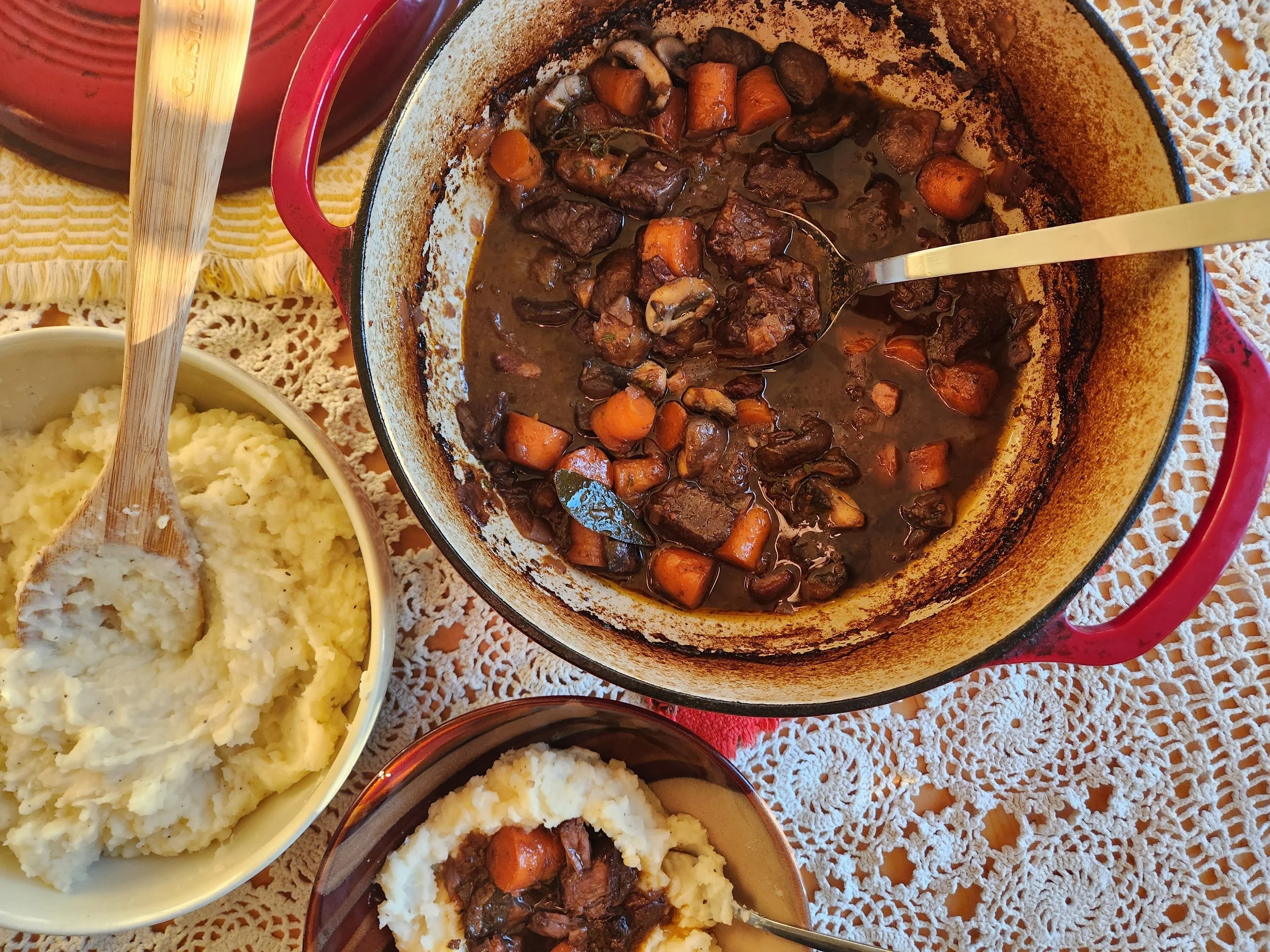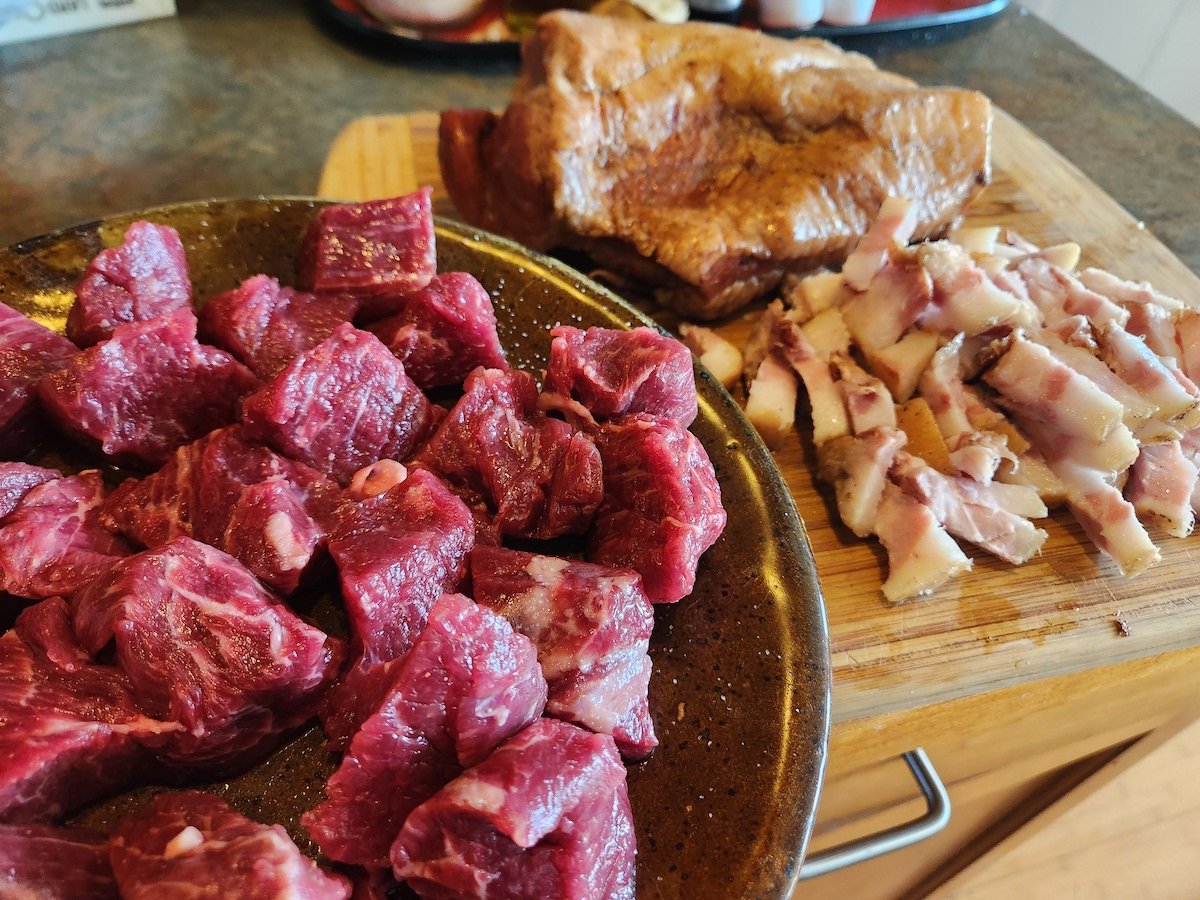Beef Bourguignon
Beef Bourguignon with mashed potatoes.
Cold weather brings cravings for warm and comforting meals. Scrolling Instagram on Saturday morning, I came across this post from Charlottesville resident and Bellair customer Elizabeth Stark, aka @BrooklySupper. Thoroughly inspired, I headed to the Barn for most of the ingredients and sent my husband to Blenhiem for a couple of bottles of wine.
Bellair pre-cut stew beef and smoked pork jowl.
I did make some pretty big changes to Elizabeth's recipe based on what I had available. I didn't have pearl onions, so I added in some shallots with the diced onion at the beginning. I subbed in diced smoked Bellair pork jowl for the bacon because I love the jowl and it is great for making lardons. I also increased the carrots and decreased the mushrooms just because that's what I had. I didn't want to wait for a whole chuck roast to thaw so I used a 1# pack of pre-cut beef stew meat. I really wish I had used 2 packs, because it would have been awesome and served more meals. Since our beef and pork is so flavorful, I skipped the beef stock and just used water. I also reduced the wine because I was using less meat overall.
I served the whole thing over mashed Bellair potatoes. Overall, the dish was delicious and awesome even with all the changes! This goes to show how flexible your cooking can be to accommodate what you have available to you.
As I cooked, I thought a lot about a paragraph in Elizabeth's text about the sustainability of beef production. I think that's an idea that a lot of people are hearing about lately, and for good reason! Beef production is the #1 cause of Amazonian deforestation and feed-lot beef is one of the biggest carbon contributors on planet earth. However, I think there is a big distinction to be made when it comes to local, 100% pasture-based beef. On our farm, our beef are a vital part of their ecosystem. More so than the vegetables, more so than the hogs or the chickens, the cattle participate in and improve the ecosystem around them. As they uptake carbon in the form of grass, they deposit carbon and nitrogen in the form of manure. That process in and of itself stimulates grass growth, which results in carbon capture and more future grazing! There are entire food chains of bacteria, fungus, insects, birds, mammals and more that thrive in our rotationally grazed systems. There are many species, including several "at risk" birds that need heavy grazing in their environments in order to thrive. Our farm is "understocked" with cattle at the moment, meaning we might actually increase biodiversity if we can increase beef production.
One good thing to keep in mind is that the science on carbon capture/sequestration is really limited. We have a hard time understanding massive global systems like these. Often, a study will come to some conclusion by looking at one part of the reality. There's no doubt that feedlot beef imported from South America is terrible in terms of greenhouse gas emissions. On the other hand, I look out onto our pastures and I just think "apples and oranges." There are several newer studies that indicate that grasslands 1) are a much bigger carbon sink than originally thought because the carbon is stored in the soil rather than in the plant material and 2) these carbon sinks are more resilient than other carbon sinks (like forests) because of their capacity for quick regeneration as well as their resiliency in the case of fire. You can check out a couple of those studies here and here as well as a blog post from another pasture-based farm here.
I am not a climate scientist nor do I claim any of these observations as pure fact, but I do understand there is a clear difference between growing and transporting grain to feedlot cattle in a foreign country and raising cattle on permanent pasture and never transporting them beyond central Virginia. For me, I'm eating more beef than I ever have (after being a vegetarian for 15 years) and I don't feel guilty about it. I also don't feel that it is expensive! Pound for pound, Bellair's ground beef is cheaper than ANY of our other ground products -- pork, chicken, turkey and goat -- and it is the ONLY one of those options that is grown without the need for bought-in grains.
This is all just another perspective for you, for what it is worth! All decisions are valid and we are all out here doing our best in this complicated and globalized world. We respect the food choices of all humans! If you do eat beef, occasionally or often, check out this recipe for some rib-sticking comfort!
Pork ‘lardons’ rendering and crisping in the dutch oven.
Michelle's Version Beef Bourguignon
Here is Elizabth's original recipe for reference
2 lb beef Bellair stew meat (I used 1 lb but your should use 2. You can also sub chuck roast, cut into chunks if you like)
salt and pepper to taste
8 ounces smoked Bellair hog jowl, cut into 1/3 inch cubes
1 large yellow onion, diced
2 shallots, diced
1 bunch Bellair carrots, cut to 1 inch
2 cloves garlic minced
2 tablespoon tomato paste
2 cups dry red wine, such as Pinot Noir
1 cup water, plus more if needed
5 sprigs fresh thyme
2 bay leaves, preferably fresh
8 ounces cremini mushrooms, halved (16 oz would have been better)
butter, to taste
minced parsley to garnish
Beef bourguignon, ready to plate.
Season beef with salt and pepper and rest at room temp while you prepare other ingredients
Preheat oven to 350 degrees F.
Set a large Dutch oven or other wide, deep-sided pot over medium-low heat. Add jowl and cook until golden and crispy and lots of fat has rendered, about 10 minutes. Remove to a paper towel-lined plate with a slotted spoon. Turn heat just a bit higher than medium – fat should be hot but not smoking. Working in batches, sear beef on all sides, about 12 minutes total. Remove cooked meat to a plate. Repeat for remaining batches, edging heat down as needed.
Tie 4 sprigs each parsley and thyme, along with 2 bay leaves into a little bundle with kitchen twine to make the bouquet garnis.
Turn heat down to medium, and add the onion, shallots and carrot. Sauté 10 minutes, stirring often. Add garlic and tomato paste, and cook 1 minute more. Add half the wine, scrape the bottom of the pot to dislodge any brown bits, then add remaining wine, water, seared beef and any accumulated juices, jowl, and the bouquet garnis. Cover and slide into the oven. Cook 1 1/2 - 2 hours, or until beef is very tender. Start checking at the 1 1/2 hour mark. As you check, give the beef a stir, and add salt and pepper to taste.
When the meat is almost tender, set a skillet over medium-high heat. Add 2 tablespoons butter and the mushrooms. Sauté until golden, 5 - 7 minutes. Remove to a bowl and finish with a pinch each of salt and pepper.
Remove braising pot from oven and uncover. Remove bouquet garnis and stir in the mushrooms. Taste, and add salt or pepper as needed.
Serve over mashed potatoes or polenta, garnished with a sprinkle of minced parsley.





